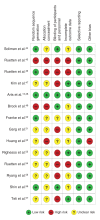Minimally invasive versus open surgery for cervical and lumbar discectomy: a systematic review and meta-analysis
- PMID: 25485257
- PMCID: PMC4251505
- DOI: 10.9778/cmajo.20140048
Minimally invasive versus open surgery for cervical and lumbar discectomy: a systematic review and meta-analysis
Abstract
Introduction: Minimally invasive surgery for discectomy may accelerate recovery and reduce pain, but it also requires technical expertise and is associated with increased risks. We performed a meta-analysis to determine the effects of minimally invasive versus open surgery on functional outcomes, pain, complications and reoperations among patients undergoing cervical or lumbar discectomy.
Methods: We searched MEDLINE, Embase and the Cochrane Library for reports of relevant randomized controlled trials published to Jan. 12, 2014. Two reviewers assessed the eligibility of potential reports and the risk of bias of included trials. We analyzed functional outcomes and pain using standardized mean differences (SMDs) that were weighted and pooled using a random-effects model.
Results: We included 4 trials in the cervical discectomy group (n = 431) and 10 in the lumbar discectomy group (n = 1159). Evidence overall was of low to moderate quality. We found that minimally invasive surgery did not improve long-term function (cervical: SMD 0.11, 95% confidence interval [CI] -0.09 to 0.31; lumbar: SMD 0.04, 95% CI -0.11 to 0.20) or reduce long-term extremity pain (cervical: SMD -0.21, 95% CI -0.52 to 0.10; lumbar: SMD 0.08, 95% CI -0.16 to 0.32) compared with open surgery. The evidence suggested overall higher rates of nerve-root injury (risk ratio [RR] 1.62, 95% CI 0.45 to 5.84), incidental durotomy (RR 1.56, 95% CI 0.80 to 3.05) and reoperation (RR 1.48, 95% CI 0.97 to 2.26) with minimally invasive surgery than with open surgery. Infections were more common with open surgery than with minimally invasive surgery (RR 0.24, 95% CI 0.04 to 1.38), although the difference was not statistically significant.
Interpretation: Current evidence does not support the routine use of minimally invasive surgery for cervical or lumbar discectomy. Well-designed trials are needed given the lack of high-quality evidence.
Conflict of interest statement
Figures






References
-
- Konstantinou K, Dunn KM. Sciatica: review of epidemiological studies and prevalence estimates. Spine 2008;33:2464-72. - PubMed
-
- Matsumoto M, Fujimura Y, Suzuki N, et al. MRI of cervical intervertebral discs in asymptomatic subjects. J Bone Joint Surg Br 1998;80:19-24. - PubMed
-
- Cenic A, Kachur E. Lumbar discectomy: a national survey of neurosurgeons and literature review. Can J Neurol Sci 2009;36:196-200. - PubMed
-
- Atlas SJ, Keller RB, Wu YA, et al. Long-term outcomes of surgical and nonsurgical management of sciatica secondary to a lumbar disc herniation: 10 year results from the Maine Lumbar Spine study. Spine 2005;30:927-35. - PubMed
LinkOut - more resources
Full Text Sources
Other Literature Sources
Medical
